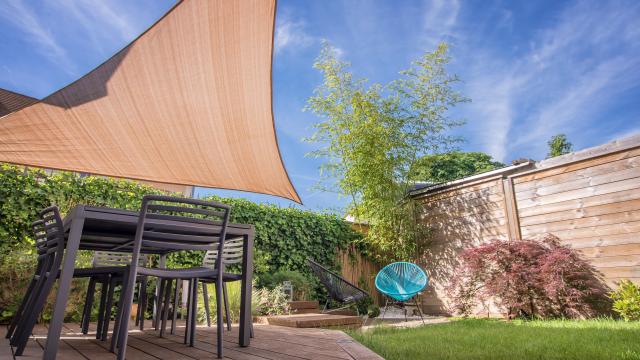If you’re interested in spending more time in the yard this summer, but need to increase your shaded areas to make it more cool and comfortable, a shade sail might be for you. Unlike a roof, a shade sail is intended to let air circulate through it while providing a cooler spot. Shade sails are also removable, making them good for areas with high winds or storms. They won’t pose a danger to nearby structures — like your house.
Choose a shade sail and plan your configuration
A shade sail can come with either three or four corners and will have eyelets in each, allowing the sail to be stretched across an open area. They come in a variety of colours, but the best ones will be a light colour, to avoid absorbing too much heat from the sun.
Planning your placement should take local building codes into account. Also consider the direction of the sun when you’re most likely to be using it, and of course, aesthetics. You don’t have to install them level to the ground, so you can adjust the post height based on your preferences.
What you’ll need to install your shade sail
This project involves digging deep post holes and using posts to attach your shade sail. You should always make sure that you’re clear of buried utility lines before you dig, so if you live in the United States, dial 811. They will help you to locate and avoid any possible hazards. Once that’s done, you’ll need the following things:
- Some posts
- Some medium gravel
- Concrete
- Some clamps
- A shovel
In addition, if your shade sail doesn’t come with hardware to attach it, you’ll also need two quick links for each corner, one turnbuckle for each corner, one eye bolt, and one lag bolt or hold-down bolt for each post, a drill, and a wrench. It helps to also have a sturdy rope or parachute cord hold the tension of the sail while you attach the hardware.
How to install a shade sail
Prepare your posts by drilling a hole through the top of each one and bolting your eye bolt into the hole, making sure that the pole firmly attached and can’t spin or slip. Attach one quick link though each eye bolt and use the quick link to attach your turnbuckle. Attach a lag bolt or a hold-down bolt to the bottom of each post. Set your posts aside and grab your shovel.
To adequately anchor your shade sail, you’ll need to dig a hole at least ⅓ the length of your post. That means if you want your sail nine feet in the air, your post hole needs to be three feet deep. Keep in mind when you’re planning out your posts that the tops need to be a little bit farther apart than the area of the sail to accommodate your tensioning hardware. It is also recommended you angle your posts five degrees away from the centre of the shade sail area. This will help counteract the force being applied to your posts, but also add to the distance between posts, so be sure to add that into your layout calculations. Once you’ve measured, it’s time to dig your hole. For a four-inch wooden post, you’ll need a hole at least eight inches in diameter.
Digging your holes is the hardest part, so the rest is pretty easy. Line the bottom of each hole with a few inches of gravel. Mix your concrete according to the instructions on the package and place your posts in the holes at a five-degree angle from the ground, leaning away from the centre of your sail. Make sure that you have a scrap of two-by-four or similar, and a clamp to hold each post in place while your concrete dries. Pour your concrete around the posts and allow it to cure completely before moving on to the next steps. Check the package for manufacturer specifications, but most concrete will harden in 24 to 48 hours.
To hang your sail, use one quick link in each corner to attach the sail to the turnbuckle on each post. You can use your rope or paracord to hold the sail in place while you’re working with the hardware by tying one end of the rope to the shade sail and looping the other end through the eye on the eyebolt. Then, you can pull on the end that goes through the eyebolt, using it like a pulley, and taking tension off of your turnbuckle and quicklinks. Once your hardware is attached, you can untie the rope and allow the hardware to take the tension. Tighten up the turnbuckles until your sail is wrinkle-free, and you’re all set.

Leave a Reply
You must be logged in to post a comment.